MITSUBISHI SPYDER 1990 Service Owner's Guide
Manufacturer: MITSUBISHI, Model Year: 1990, Model line: SPYDER, Model: MITSUBISHI SPYDER 1990Pages: 2103, PDF Size: 68.98 MB
Page 31 of 2103
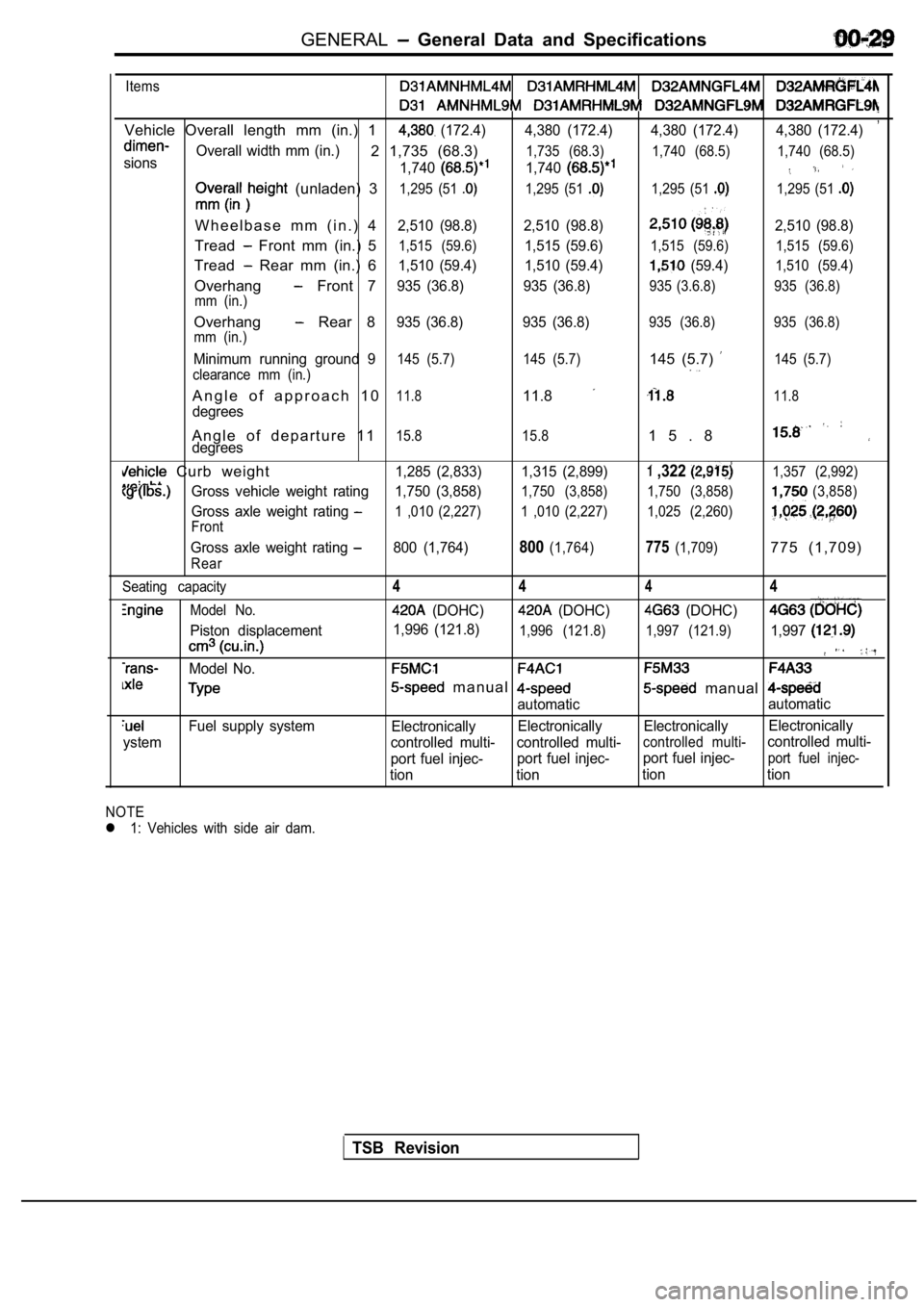
GENERAL General Data and Specifications
Items
,Vehicle Overall length mm (in.) 1 (172.4) 4,380 (172.4) 4,380 (172.4) 4,380 (172.4)
sionsOverall width mm (in.)2 1,735 (68.3)
1,740
1,735 (68.3)
1,740
1,740 (68.5) 1,740 (68.5)
(unladen) 31,295 (51 1,295 (51 1,295 (51 1,295 (51
W h e e l b a s e m m ( i n . ) 42,510 (98.8) 2,510 (98.8)2,510 (98.8)
Tread Front mm (in.) 51,515 (59.6)1,515 (59.6)1,515 (59.6) 1,515 (59.6)
Tread Rear mm (in.) 61,510 (59.4) 1,510 (59.4) (59.4)1,510 (59.4)
Overhang Front 7935 (36.8) 935 (36.8)935 (3.6.8) 935 (36.8)
mm (in.)
Overhang Rear 8935 (36.8) 935 (36.8)935 (36.8) 935 (36.8)
mm (in.)
Minimum running ground 9145 (5.7) 145 (5.7)145 (5.7) 145 (5.7)
clearance mm (in.)
A n g l e o f a p p r o a c h 1 011.811.811.8
degrees
A n g l e o f d e p a r t u r e 1 115.8 15.81 5 . 8degrees
Curb weight1,285 (2,833) 1,315 (2,899) ,322 1,357 (2,992)
Gross vehicle weight rating 1,750 (3,858)1,750 (3,858) 1,750 (3,858)(3,858)
Gross axle weight rating 1 ,010 (2,227) 1 ,010 (2,227) 1,025 (2,260)
Front
Gross axle weight rating 800 (1,764)800(1,764)775(1,709)775 (1,709)
Rear
Seating capacity
Model No.
Piston displacement
Model No.
Fuel supply system
ystem
4 444
(DOHC) (DOHC) (DOHC)
1,996 (121.8)1,996 (121.8) 1,997 (121.9)1,997
m a n u a l manual
automatic automatic
Electronically Electronically Electronically Electronically
controlled multi- controlled multi-
controlled multi-controlled multi-
port fuel injec- port fuel injec-port fuel injec-
port fuel injec-
tion tion tion tion
NOTE
l 1: Vehicles with side air dam.
TSB Revision
Page 32 of 2103
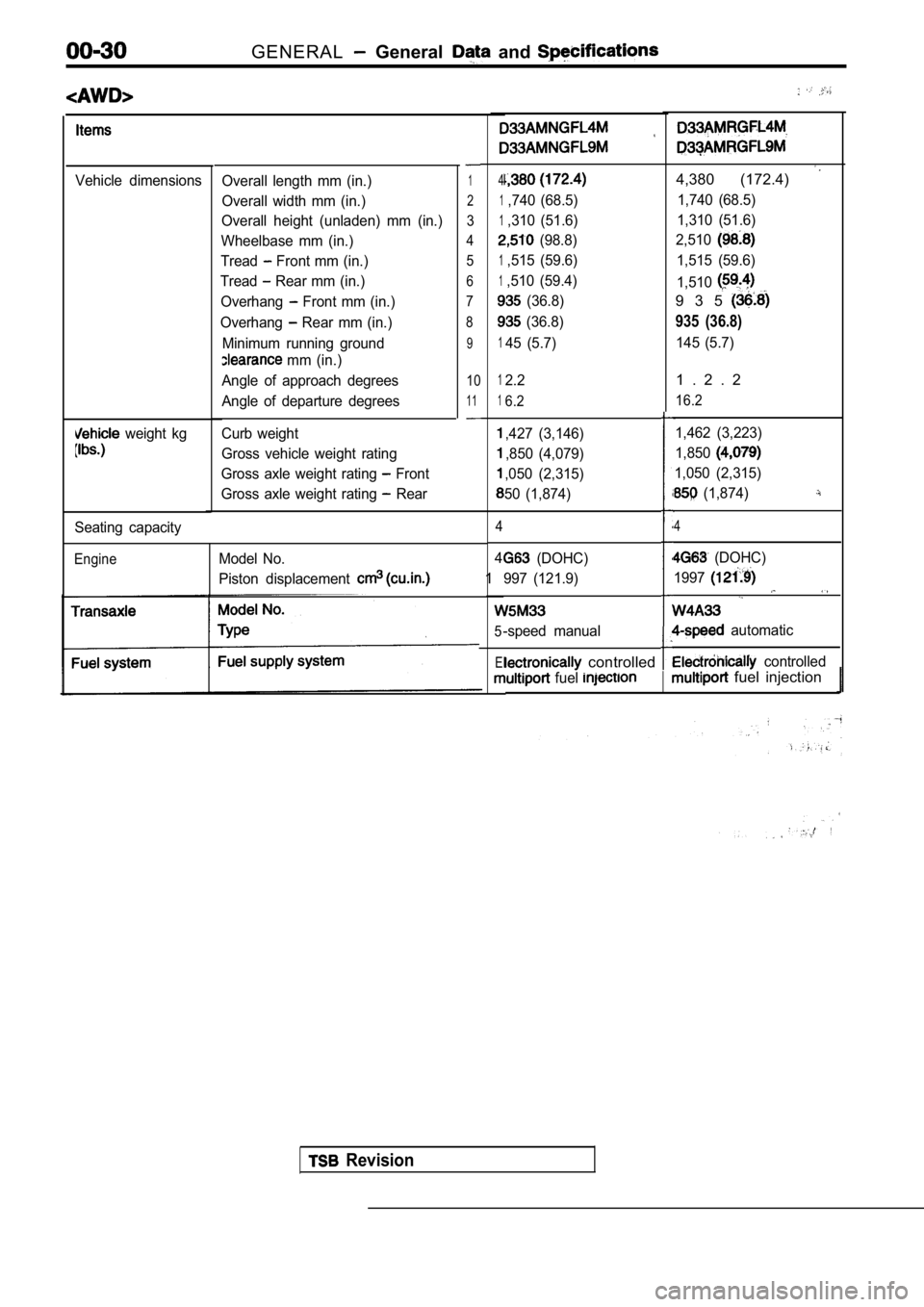
GENERAL General and
Vehicle dimensions
weight kg
Overall length mm (in.)
Overall width mm (in.)
Overall height (unladen) mm (in.)
Wheelbase mm (in.)
Tread
Front mm (in.)
Tread
Rear mm (in.)
Overhang
Front mm (in.)
Overhang
Rear mm (in.)
Minimum running ground
mm (in.)
Angle of approach degrees
Angle of departure degrees
Curb weight
Gross vehicle weight rating
Gross axle weight rating
Front
Gross axle weight rating
Rear
1
2
3
4 5
6
7
8
9
10
11
Seating capacity
EngineModel No.
Piston displacement
4
1,740 (68.5)
1,310 (51.6)
(98.8)
1,515 (59.6)
1,510 (59.4)
(36.8)
(36.8)
145 (5.7)
4,380 (172.4)
1,740 (68.5)
1,310 (51.6)
2,510
1,515 (59.6)
1,510
9 3 5
935 (36.8)
145 (5.7)
12.2
16.2
,427 (3,146)
,850 (4,079)
,050 (2,315)
50 (1,874)
4
4
1
5
El
1 . 2 . 2
16.2
1,462 (3,223)
1,850
1,050 (2,315)
(1,874)
4
(DOHC)
997 (121.9)
-speed manual
(DOHC)
1997
automatic
controlled controlled
fuel fuel injection
Revision
Page 33 of 2103
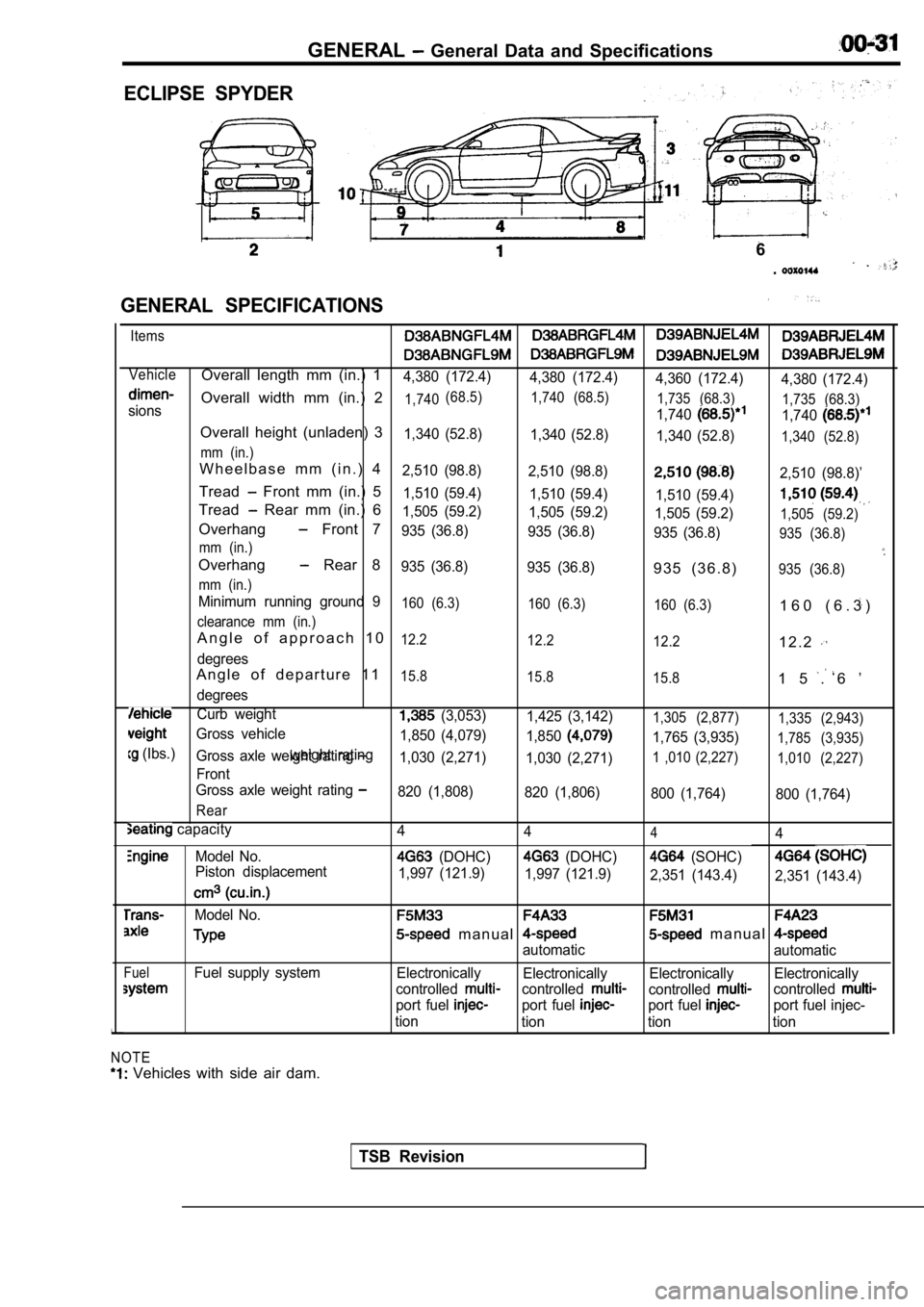
GENERAL General Data and Specifications
ECLIPSE SPYDER
GENERAL SPECIFICATIONS
6
.
Items
VehicleOverall length mm (in.) 14,380 (172.4) 4,380 (172.4)
4,360 (172.4)4,380 (172.4)
Overall width mm (in.) 21,740(68.5)
1,740 (68.5)
1,735 (68.3)1,7401,735 (68.3)sions
1,740
Overall height (unladen) 31,340 (52.8)1,340 (52.8)
1,340 (52.8)1,340 (52.8)
mm (in.)
W h e e l b a s e m m ( i n . ) 42,510 (98.8) 2,510 (98.8)2,510 (98.8)’
Tread Front mm (in.) 51,510 (59.4) 1,510 (59.4)
1,510 (59.4)
Tread Rear mm (in.) 61,505 (59.2) 1,505 (59.2)
1,505 (59.2)1,505 (59.2)Overhang Front 7935 (36.8) 935 (36.8)
935 (36.8)935 (36.8)
mm (in.)
Overhang Rear 8935 (36.8) 935 (36.8)9 3 5 ( 3 6 . 8 )935 (36.8)
mm (in.)
Minimum running ground 9160 (6.3) 160 (6.3)
160 (6.3)1 6 0 ( 6 . 3 )
clearance mm (in.)
A n g l e o f a p p r o a c h 1 012.2 12.2
12.21 2 . 2
degrees
A n g l e o f d e p a r t u r e 1 115.8 15.8
15.81 5 . 6 ’
degrees
Curb weight (3,053)1,425 (3,142)1,305 (2,877) 1,335 (2,943)
Gross vehicle
1,765 (3,935)1,785 (3,935)
(Ibs.)weight rating1,850 (4,079)
1,850Gross axle weight rating 1,030 (2,271)1,030 (2,271)1 ,010 (2,227) 1,010 (2,227)
Front
Gross axle weight rating
820 (1,808) 820 (1,806)
800 (1,764)800 (1,764)
Rear
capacity
Model No.
Piston displacement
Model No.
FuelFuel supply system
NOTE
Vehicles with side air dam. 4
444
(DOHC) (DOHC) (SOHC)
1,997 (121.9)
1,997 (121.9)
2,351 (143.4)2,351 (143.4)
m a n u a l m a n u a l
automatic automatic
Electronically Electronically Electronically Electronically
controlled
controlledcontrolledcontrolled
port fuel port fuel port fuel port fuel injec-
tion tion tion tion
TSB Revision
Page 34 of 2103
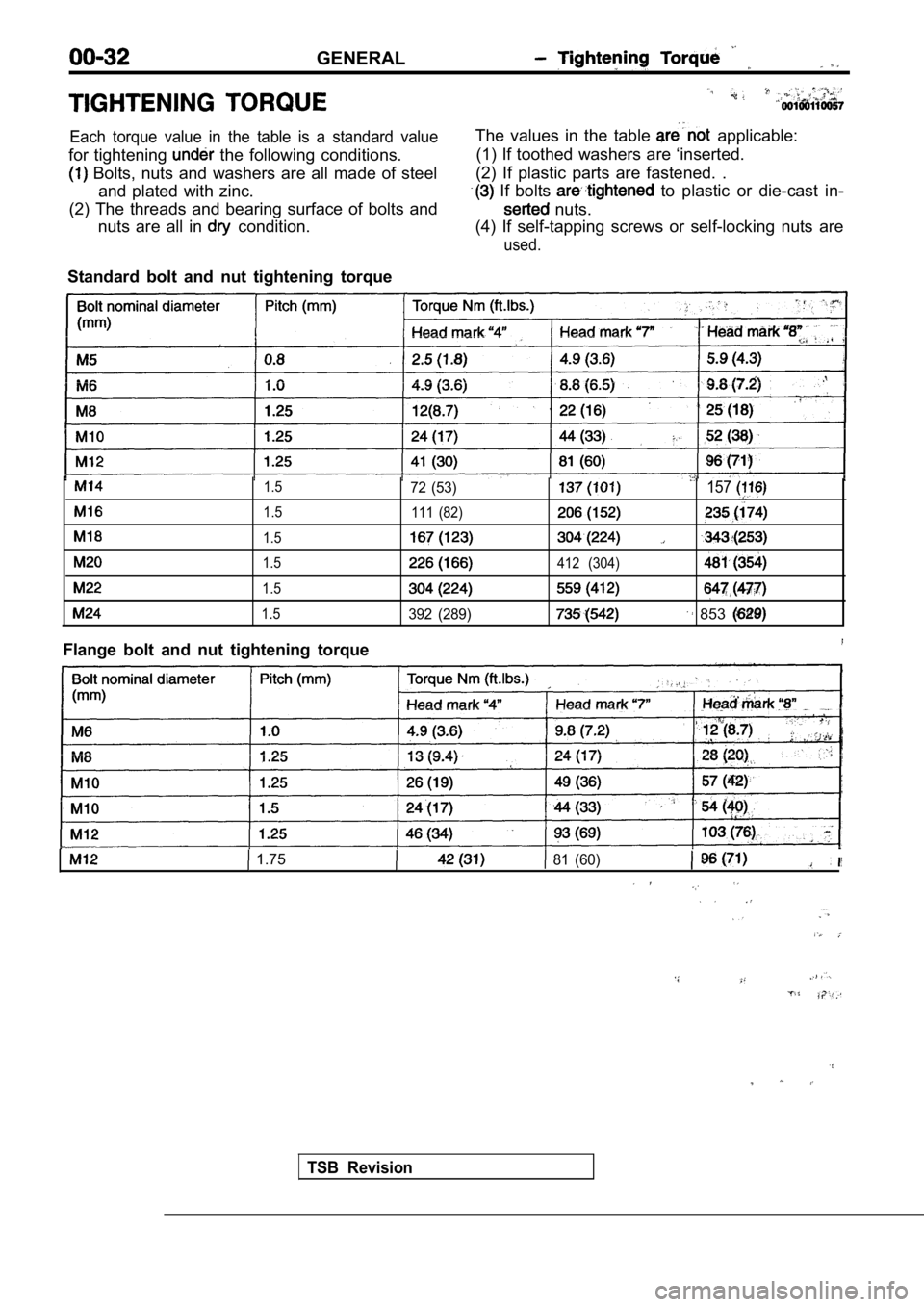
GENERAL
Each torque value in the table is a standard value
for tightening the following conditions.
Bolts, nuts and washers are all made of steeland plated with zinc.
(2) The threads and bearing surface of bolts and nuts are all in
condition. The values in the table
applicable:
(1) If toothed washers are ‘inserted.
(2) If plastic parts are fastened. .
If bolts to plastic or die-cast in-
nuts.
(4) If self-tapping screws or self-locking nuts are
used.
Standard bolt and nut tightening torque
1.5
1.5
1.5
1.5
1.5
1.5
Flange bolt and nut tightening torque
72 (53)157
111 (82)
412 (304)
392 (289) 853
1.7581 (60)
TSB Revision
Page 35 of 2103
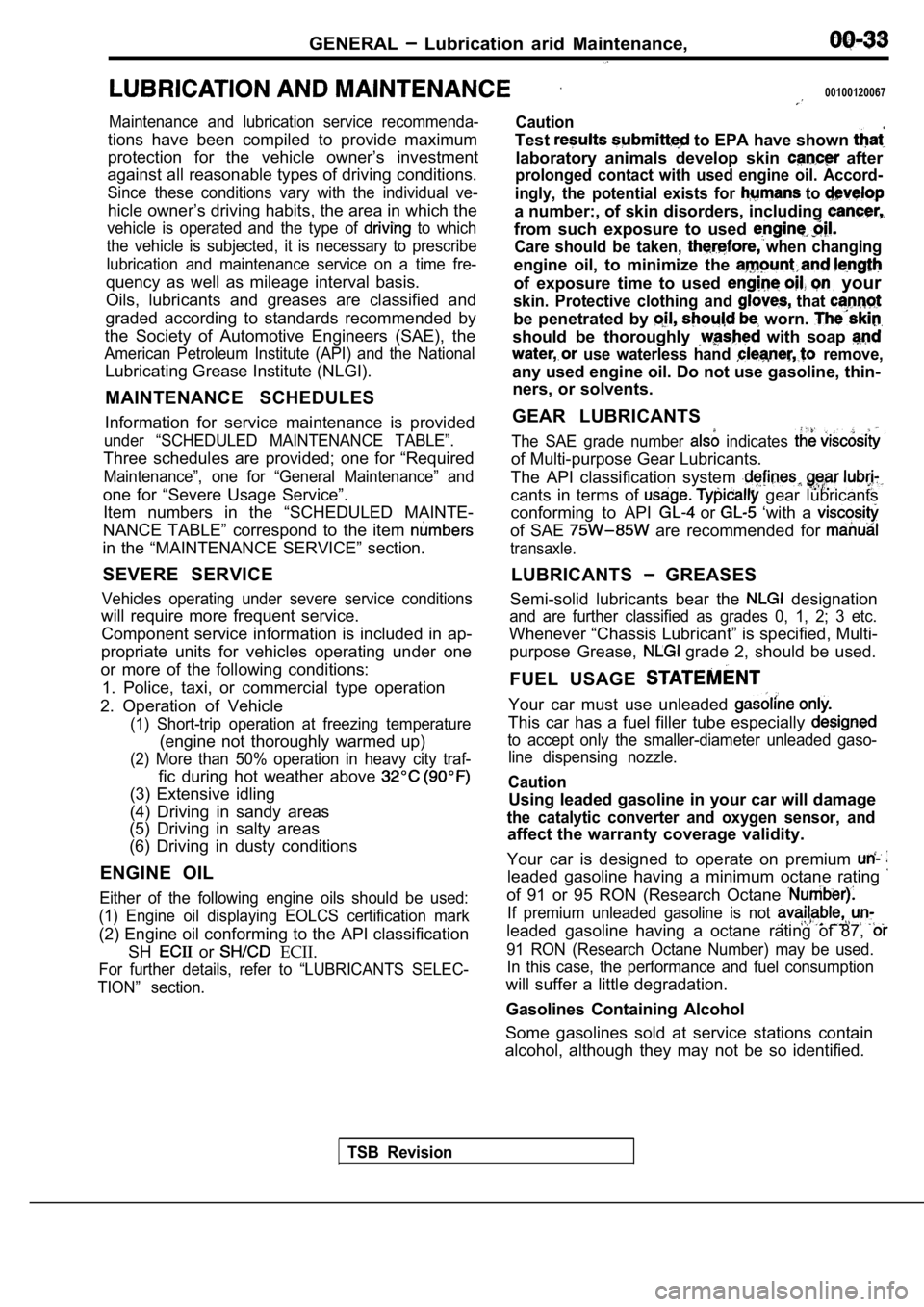
GENERAL Lubrication arid Maintenance,
00100120067
Maintenance and lubrication service recommenda-
tions have been compiled to provide maximum
protection for the vehicle owner’s investment
against all reasonable types of driving conditions.
Since these conditions vary with the individual ve-
hicle owner’s driving habits, the area in which the
vehicle is operated and the type of to which
the vehicle is subjected, it is necessary to prescr ibe
lubrication and maintenance service on a time fre-
quency as well as mileage interval basis.
Oils, lubricants and greases are classified and
graded according to standards recommended by
the Society of Automotive Engineers (SAE), the
American Petroleum Institute (API) and the National
Lubricating Grease Institute (NLGI).
MAINTENANCE SCHEDULES
Information for service maintenance is provided
under “SCHEDULED MAINTENANCE TABLE”.
Three schedules are provided; one for “Required
Maintenance”, one for “General Maintenance” and
one for “Severe Usage Service”. Item numbers in the “SCHEDULED MAINTE-
NANCE TABLE” correspond to the item
in the “MAINTENANCE SERVICE” section.
SEVERE SERVICE
Vehicles operating under severe service conditions
will require more frequent service. Component service information is included in ap-
propriate units for vehicles operating under one
or more of the following conditions:
1. Police, taxi, or commercial type operation
2. Operation of Vehicle
(1) Short-trip operation at freezing temperature
(engine not thoroughly warmed up)
(2) More than 50% operation in heavy city traf-
fic during hot weather above
(3) Extensive idling
(4) Driving in sandy areas
(5) Driving in salty areas
(6) Driving in dusty conditions
ENGINE OIL
Either of the following engine oils should be used:
(1) Engine oil displaying EOLCS certification mark
(2) Engine oil conforming to the API classification SH
or ECII.
For further details, refer to “LUBRICANTS SELEC-
TION” section.
Caution
Test to EPA have shown
laboratory animals develop skin after
prolonged contact with used engine oil. Accord-
ingly, the potential exists for
to
a number:, of skin disorders, including
from such exposure to used
Care should be taken, when changing
engine oil, to minimize the
of exposure time to used your
skin. Protective clothing and that
be penetrated by worn.
should be thoroughly with soap
use waterless hand remove,
any used engine oil. Do not use gasoline, thin- ners, or solvents.
GEAR LUBRICANTS
The SAE grade number indicates
of Multi-purpose Gear Lubricants.
The API classification system
cants in terms of gear lubricants
conforming to API
or ‘with a
of SAE are recommended for
transaxle.
LUBRICANTS GREASES
Semi-solid lubricants bear the
designation
and are further classified as grades 0, 1, 2; 3 etc .
Whenever “Chassis Lubricant” is specified, Multi-
purpose Grease,
grade 2, should be used.
FUEL USAGE
Your car must use unleaded
This car has a fuel filler tube especially
to accept only the smaller-diameter unleaded gaso- line dispensing nozzle.
Caution
Using leaded gasoline in your car will damage
the catalytic converter and oxygen sensor, and
affect the warranty coverage validity.
Your car is designed to operate on premium
leaded gasoline having a minimum octane rating
of 91 or 95 RON (Research Octane
If premium unleaded gasoline is not
leaded gasoline having a octane rating of 87,
91 RON (Research Octane Number) may be used. In this case, the performance and fuel consumption
will suffer a little degradation.
Gasolines Containing Alcohol
Some gasolines sold at service stations contain
alcohol, although they may not be so identified.
TSB Revision
Page 36 of 2103
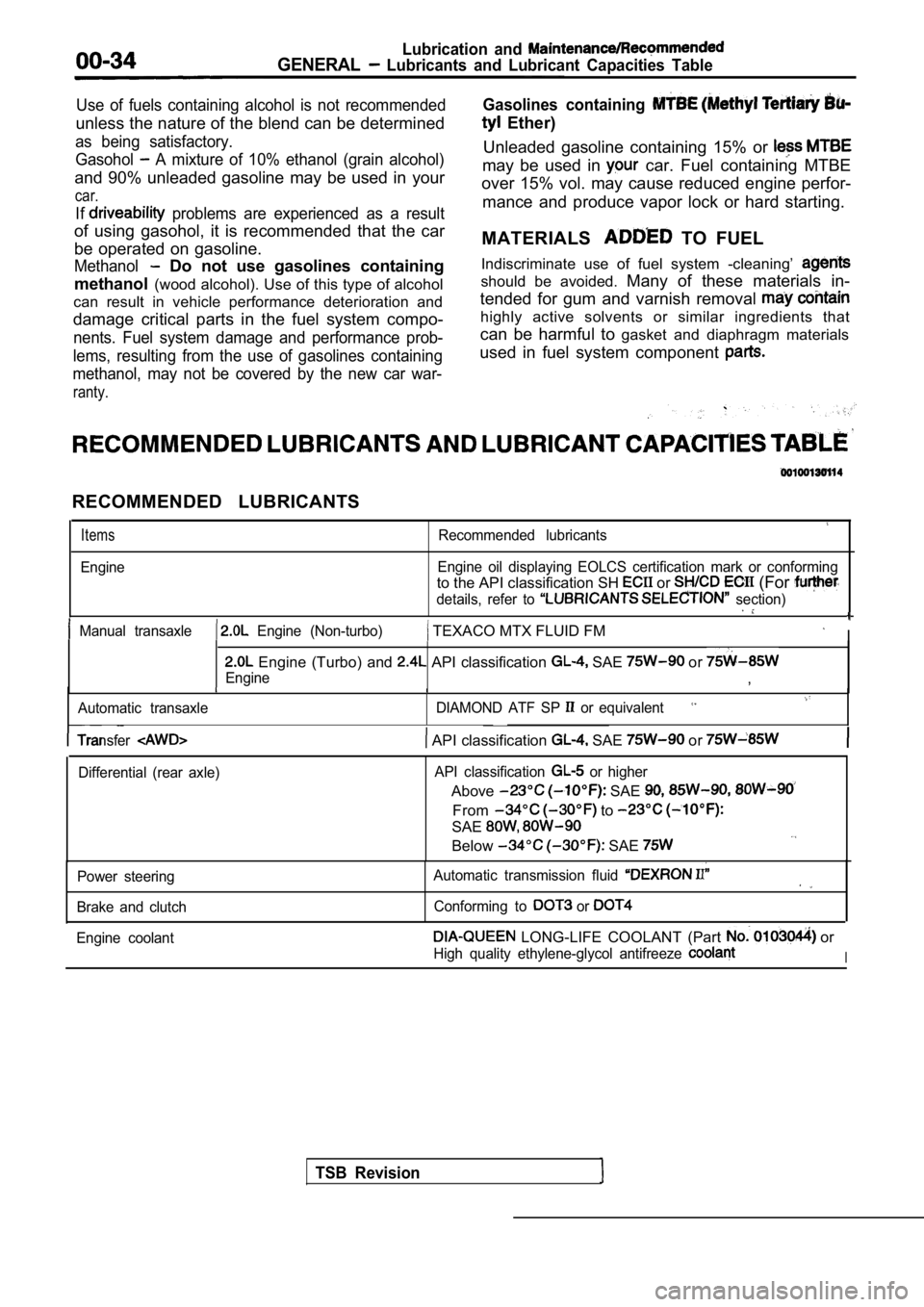
Lubrication and
GENERAL Lubricants and Lubricant Capacities Table
Use of fuels containing alcohol is not recommended
unless the nature of the blend can be determined
as being satisfactory.
Gasohol
A mixture of 10% ethanol (grain alcohol)
and 90% unleaded gasoline may be used in your
car.
If problems are experienced as a result
of using gasohol, it is recommended that the car
be operated on gasoline.
Methanol Do not use gasolines containing
methanol (wood alcohol). Use of this type of alcohol
can result in vehicle performance deterioration and
damage critical parts in the fuel system compo-
nents. Fuel system damage and performance prob-
lems, resulting from the use of gasolines containin g
methanol, may not be covered by the new car war-
ranty.
Gasolines containing
Ether)
Unleaded gasoline containing 15% or
may be used in car. Fuel containing MTBE
over 15% vol. may cause reduced engine perfor-
mance and produce vapor lock or hard starting.
MATERIALS
TO FUEL
Indiscriminate use of fuel system -cleaning’
should be avoided. Many of these materials in-
tended for gum and varnish removal
highly active solvents or similar ingredients that
can be harmful to gasket and diaphragm materials
used in fuel system component
RECOMMENDED LUBRICANTS
Items
Engine
Recommended lubricants
Engine oil displaying EOLCS certification mark or c onforming
to the API classification SH or (For
details, refer to section)
Manual transaxle Engine (Non-turbo) TEXACO MTX FLUID FM I
Engine (Turbo) and API classification SAE or
Engine,
Automatic transaxle DIAMOND ATF SP or equivalent
TSB Revision
Transfer API classification SAE or
Differential (rear axle)API classification or higher
Above SAE
From to
SAE
Below SAE
Power steering
Brake and clutch Automatic transmission fluid
Conforming to or
Engine coolant LONG-LIFE COOLANT (Part or
High quality ethylene-glycol antifreeze I
Page 37 of 2103
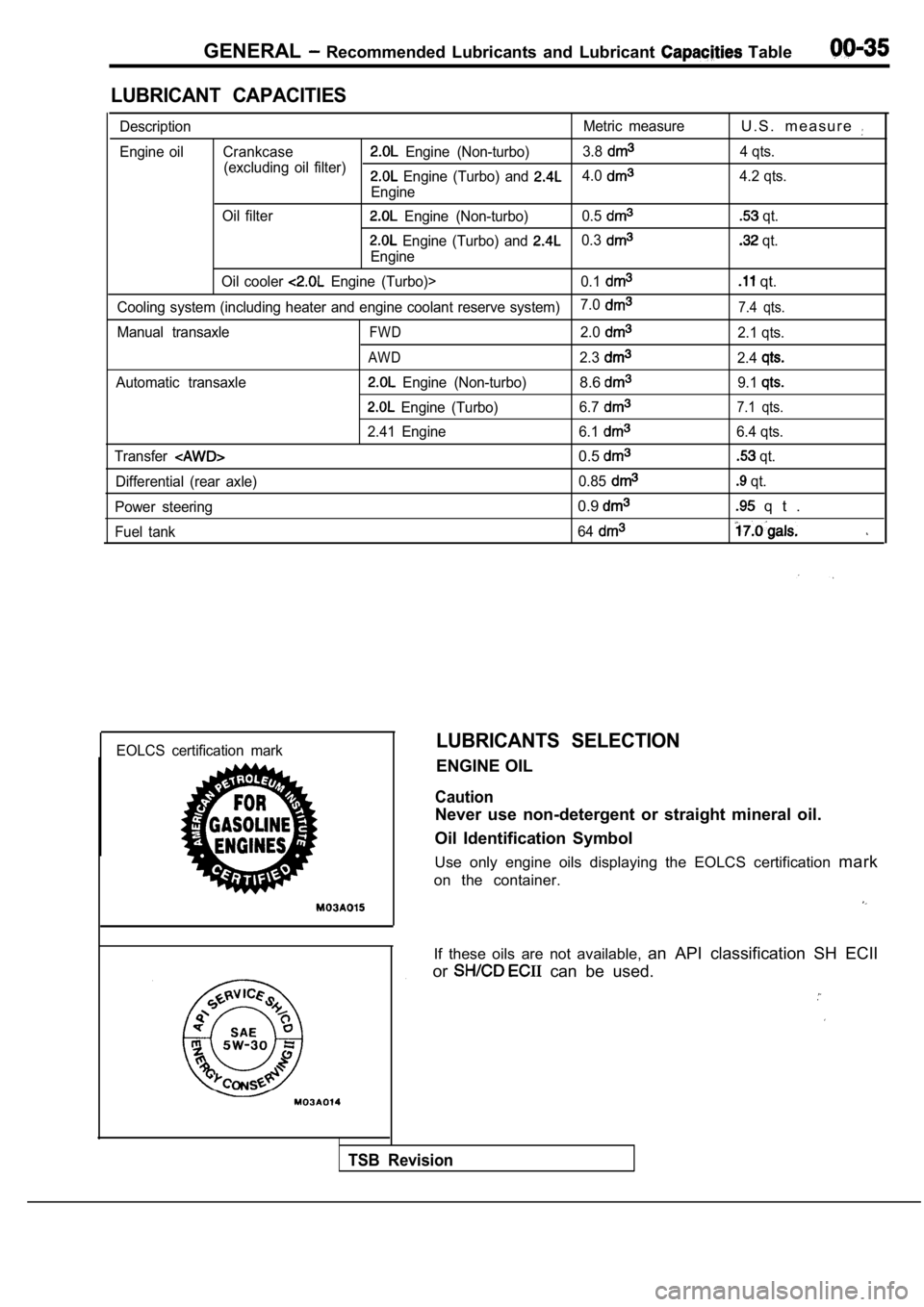
GENERAL Recommended Lubricants and Lubricant Table
LUBRICANT CAPACITIES
DescriptionMetric measureU . S . m e a s u r e
Engine oil Crankcase Engine (Non-turbo)3.8
(excluding oil filter) 4 qts. Engine (Turbo) and 4.0
Engine4.2 qts.
Oil filter
Engine (Non-turbo) 0.5 qt.
Engine (Turbo) and 0.3
Engine
qt.
Oil cooler
Engine (Turbo)> 0.1 qt.
Cooling system (including heater and engine coolant reserve system)7.07.4 qts.
Manual transaxleFWD2.02.1 qts.
AWD2.32.4
Automatic transaxle Engine (Non-turbo)8.69.1
Engine (Turbo)
6.77.1 qts.
2.41 Engine 6.16.4 qts.
Transfer
0.5 qt.
Differential (rear axle) 0.85
qt.
Power steering
0.9 q t .
Fuel tank 64
EOLCS certification markLUBRICANTS SELECTION
ENGINE OIL
Caution
Never use non-detergent or straight mineral oil.
Oil Identification Symbol
Use only engine oils displaying the EOLCS certifica tion mark
on the container.
If these oils are not available, an API classification SH ECII
or
can be used.
TSB Revision
Page 38 of 2103
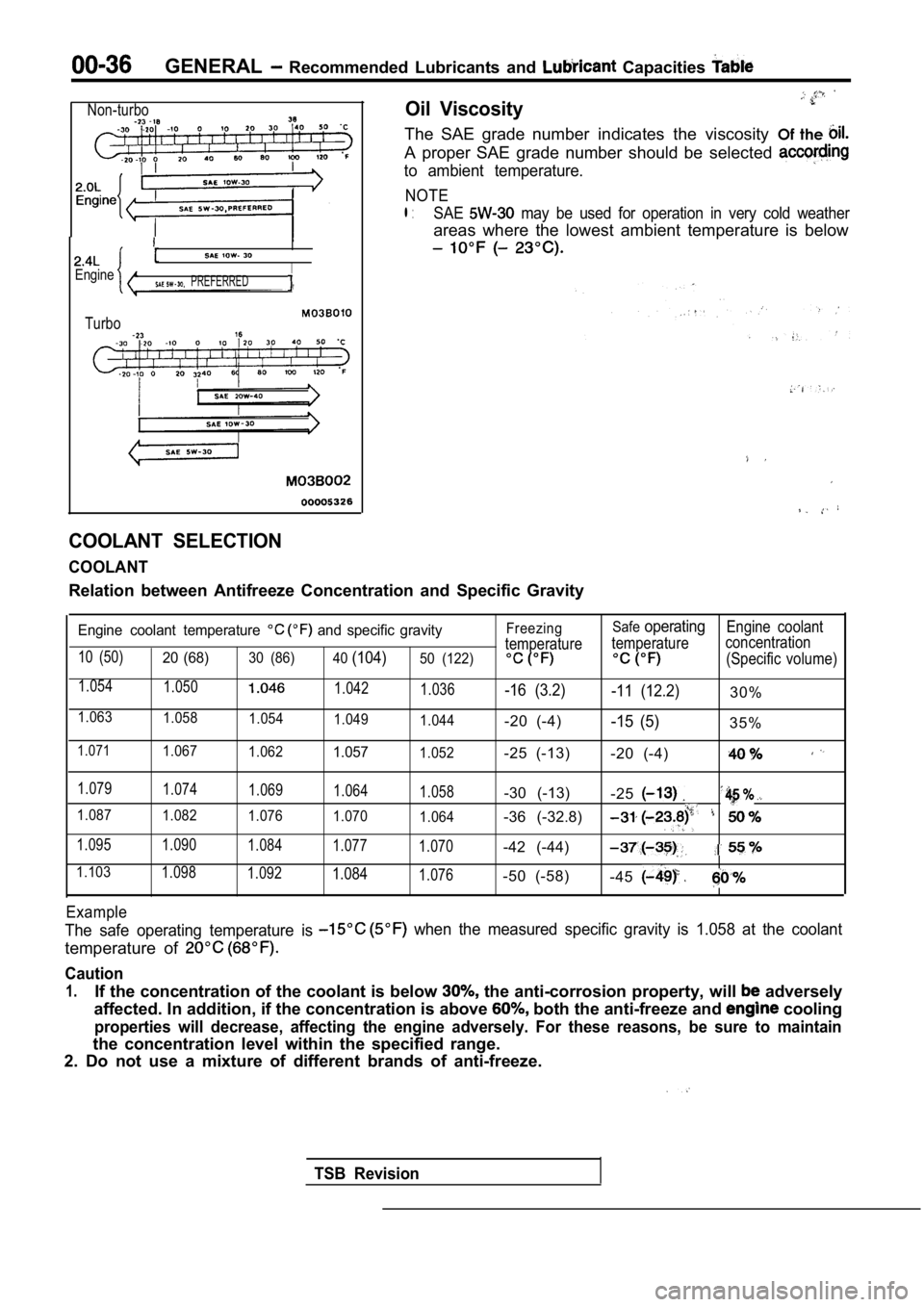
GENERAL Recommended Lubricants and Capacities
Non-turbo
I
EngineI PREFERRED
Turbo
Oil Viscosity
The SAE grade number indicates the viscosity Of the
A proper SAE grade number should be selected
to ambient temperature.
NOTE
l :SAE may be used for operation in very cold weather
areas where the lowest ambient temperature is below
COOLANT SELECTION
COOLANT
Relation between Antifreeze Concentration and Speci fic Gravity
Engine coolant temperature and specific gravity
10 (50)20 (68)30 (86)
40(104)50 (122)
1.054
1.0501.042
1.036
1.0631.058 1.0541.049
1.044
1.0711.0671.0621.0571.052 Freezing
Safe
operatingEngine coolant
temperature temperature concentration
(Specific volume)
-16 (3.2)
-11 (12.2)30%
-20 (-4)
-15 (5)35%
-25 (-13) -20 (-4)
1.079
1.074 1.0691.064
1.058-30 (-13)-25
1.0871.082 1.0761.070
1.064-36 (-32.8)
1.095 1.090 1.0841.077
1.070-42 (-44)
1.1031.0981.0921.0841.076-50 (-58)-45
Example
The safe operating temperature is when the measured specific gravity is 1.058 at the coolant
temperature of
Caution
1.If the concentration of the coolant is below the anti-corrosion property, will adversely
affected. In addition, if the concentration is abov e
both the anti-freeze and cooling
properties will decrease, affecting the engine adve rsely. For these reasons, be sure to maintain
the concentration level within the specified range.
2. Do not use a mixture of different brands of anti -freeze.
TSB Revision
Page 39 of 2103
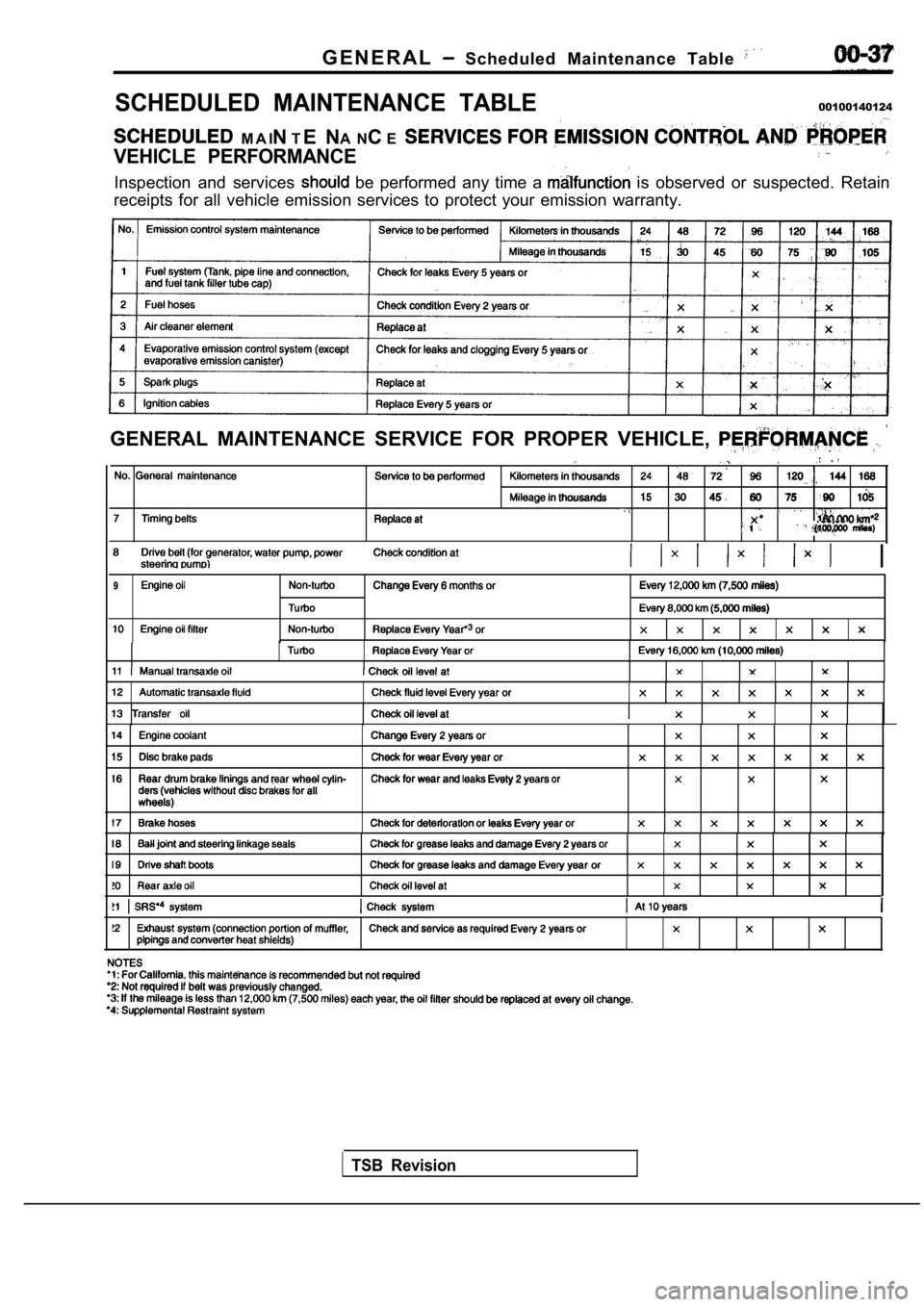
G E N E R A L Scheduled Maintenance Table
SCHEDULED MAINTENANCE TABLE00100140124
M A INTE N A NCE
VEHICLE PERFORMANCE
Inspection and services be performed any time a is observed or suspected. Retain
receipts for all vehicle emission services to prote ct your emission warranty.
GENERAL MAINTENANCE SERVICE FOR PROPER VEHICLE,
I
9
TSB Revision
Page 40 of 2103
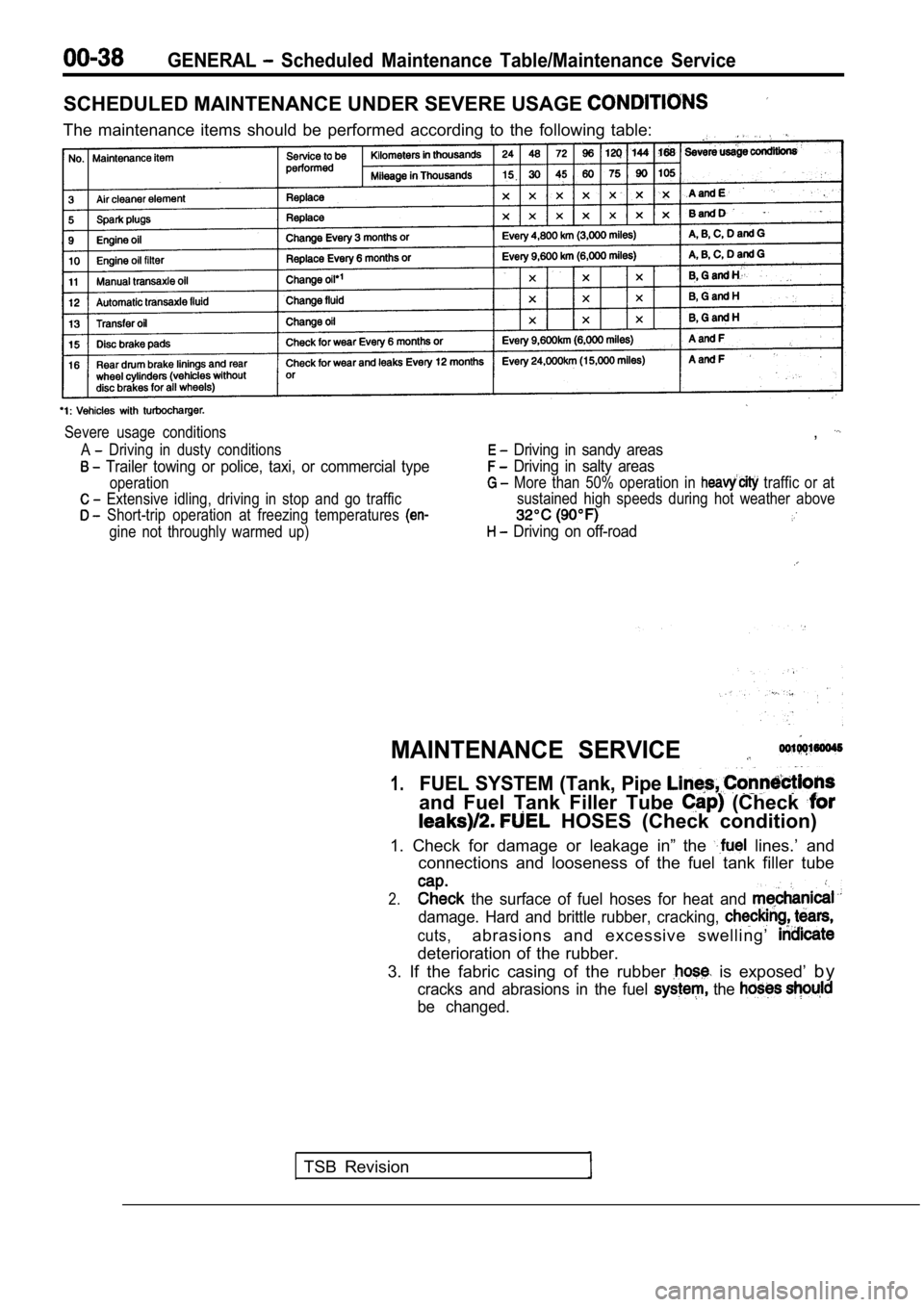
GENERAL Scheduled Maintenance Table/Maintenance Service
SCHEDULED MAINTENANCE UNDER SEVERE USAGE
The maintenance items should be performed according to the following table:
Severe usage conditions
A
Driving in dusty conditions
Trailer towing or police, taxi, or commercial type
operation
Extensive idling, driving in stop and go traffic
Short-trip operation at freezing temperatures
gine not throughly warmed up)
,
Driving in sandy areas
Driving in salty areas
More than 50% operation in traffic or at
sustained high speeds during hot weather above
Driving on off-road
MAINTENANCE SERVICE
1.FUEL SYSTEM (Tank, Pipe
and Fuel Tank Filler Tube (Check
HOSES (Check condition)
1. Check for damage or leakage in” the
lines.’ and
connections and looseness of the fuel tank filler t ube
2. the surface of fuel hoses for heat and
damage. Hard and brittle rubber, cracking,
cuts,abrasions and excessive swelling’
deterioration of the rubber.
3. If the fabric casing of the rubber
is exposed’ b y
cracks and abrasions in the fuel the
be changed.
TSB Revision